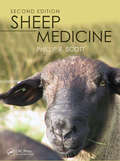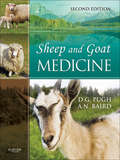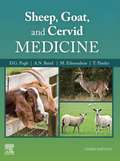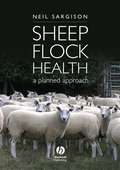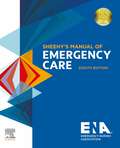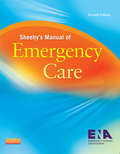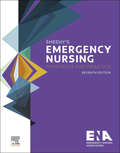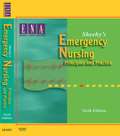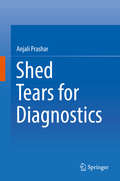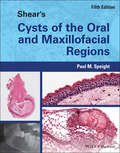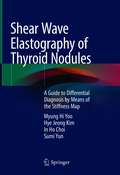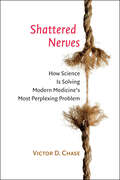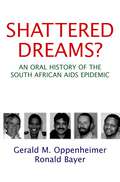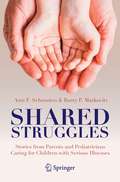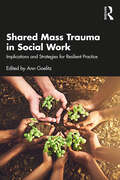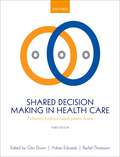- Table View
- List View
Sheep Medicine
by Philip R. ScottSheep Medicine, Second Edition describes key sheep diseases encountered in general practice along with their diagnoses, treatment, prognoses, control, and, where appropriate, post-mortem features. The book is divided into chapters covering each body system. Each chapter of this completely revised and updated book opens with a recommended approach t
Sheep & Goat Medicine - E-Book
by David G. Pugh N. (Nickie) BairdAuthoritative yet easy to read, Sheep and Goat Medicine, 2nd Edition covers all the latest advances in sheep and goat medicine, including medical treatment, surgery, theriogenology, and nutrition. Full-color photographs and clear instructions provide the answers you need, guiding you through common procedures and techniques such as restraint for examination, administration of drugs, blood collection, and grooming; these descriptions are often accompanied by explanatory diagrams and charts. With diseases, surgeries, and treatments organized by body system, information is always easy to find. New to this edition are chapters on parasite control, nutritional requirements, and performing a necropsy. Developed by Dr. D.G. Pugh, a world-renowned expert on the medical care of sheep and goats, this reference is unmatched for its comprehensive coverage of herd health, physical examination, anesthesia, and multisystem diseases.Clear writing style makes the book useful and easy to understand, even for sheep and/or goat owners who are not veterinarians.Both surgery and medicine are covered in each body systems chapter, so it's easier to choose between treatment options for specific disorders.Superbly illustrated surgical procedures clearly demonstrate the steps to follow in performing surgical procedures.An explanation of the differences in normal behavior between sheep and goats shows how they are not the same, and require different methods of treatment.A consistent, logical format in each body systems chapter makes information easy to find by beginning with physical examination and diagnostic procedures, followed by discussions of common diseases that involve the system. Consistent headings include pathogenesis, clinical signs, diagnosis, treatment, and prevention. A comprehensive nutrition chapter covers diet evaluation, method of balancing rations, total parenteral nutrition, and examples of nutritious diets.Practical formulas are included for making sodium sulfite for testing passive transfer, and Sheather's solution for fecal flotation.Useful appendixes summarize essential information on drugs and drug dosages, fluid therapy, and normal values and conversions.A diverse, authoritative panel of contributors provides current information on the care of valuable breeding stock as well as pets. Full-color photographs and graphics accurately depict conditions and procedures.New Fluid Therapy and Nutritional Support chapter covers emergency and critical care essential to the care of sheep and goats.New Gastrointestinal Parasitism chapter covers treatments for parasites, key to the successful management of all flocks.New Necropsy chapter helps you prevent disease outbreaks in a flock by determining the cause of death.
Sheep, Goat, and Cervid Medicine - E-Book
by David G. Pugh N. (Nickie) Baird Misty Edmondson Thomas PasslerGet practical answers from the only guide on the care of sheep, goats, and cervids! Authoritative yet easy to read, Sheep, Goat and Cervid Medicine, 3rd Edition covers all the latest advances in the field, including diseases and medical treatment, surgery, pain management, theriogenology, and nutrition. Clear instructions and hundreds of full-color photographs guide you step by step through common procedures including restraint for examination, administration of drugs, blood collection, and grooming. New to this edition is coverage of deer and elk medicine, reflecting the growing interest in these ruminants. Written by an expert team led by Dr. D.G. Pugh, this comprehensive reference is ideal for veterinarians and also for owners of sheep and goats.Clear writing style and consistent organization makes the book easy to understand and use, with disease chapters including pathogenesis, clinical signs, diagnosis, treatment, and prevention.Coverage of both surgery and medicine in each body systems chapter makes it easier to choose between treatment options for specific disorders.Superbly illustrated surgical procedures clearly demonstrate the steps to follow in performing medical and reproductive surgery.Diverse, expert contributors include the most experienced authorities, each providing current information on the care of valuable breeding stock as well as pets.Useful appendixes, now including veterinary feed directives, offer convenient access to information on drugs and drug dosages, fluid therapy, and normal values and conversions.Consistent, logical format in each body systems chapter makes information easy to find by beginning with physical examination and diagnostic procedures, followed by discussions of common diseases that involve the system. Comprehensive Feeding and Nutrition chapter covers diet evaluation, method of balancing rations, total parenteral nutrition, and examples of nutritious diets.Explanation of the differences in normal behavior between sheep and goats shows how they are not the same, and require different methods of treatment.NEW! Coverage of cervids has been added to chapters throughout the book, reflecting the growing popularity of deer and elk.NEW! Thorough content updates are made throughout the book and reflect the latest research evidence. NEW! 170 new clinical photos have been added.NEW! Anesthesia and Pain Management chapter includes a new section on pain management strategies, reflecting the emphasis on controlling pain in small ruminants. NEW! Expert Consult website offers an online version of the book, making it easy to search the entire book electronically. NEW! Two new authors are respected and well-known veterinary medicine experts and educators: Dr. Misty Edmondson and Dr. Thomas Passler.
Sheep Flock Health: A Planned Approach
by Neil SargisonSheep Flock Health: a planned approach is a practical guide to the diagnosis and management of production limiting diseases in sheep. The problem-based approach helps both farmers and veterinary practitioners identify health problems. The focus is on good management practices to prevent disease in the first place and to optimise production. Focuses on the achievement and maintenance of optimal productivity, rather than on a catalogue of individual diseases of sheep. Written by an expert with a strong international reputation. Suitable not only for veterinarians and veterinary students, but also progressive sheep farmers.
Sheehy’s Manual of Emergency Care - E-Book
by Emergency Nurses AssociationNEW! Restructured table of contents presents anatomically related medical and trauma chapters sequentially for quick reference. NEW! Considerations for critical care in the ED. NEW! Considerations for the transgender patient. NEW! Section on human trafficking in the Interpersonal Violence and Abuse chapter. NEW! Section on violent risk assessment in the Workplace Violence chapter. NEW! Color photos insert visually highlights and clarifies key content. EXPANDED! Substance Abuse and Addiction Emergencies chapter covers methamphetamines, bath salts, marijuana edibles, opioid abuse/prescription drug abuse, heroin/Narcan, and substance abuse disorder. EXPANDED! Chapter on end-of-life includes information on palliative care considerations. UPDATED! Infectious Diseases chapter addresses coronavirus 19 (COVID-19), Ebola, and vector-borne malaria.
Sheehy’s Manual of Emergency Care - E-Book
by ENAThoroughly revised and featuring a more efficient and streamlined design, the new 7th edition of Sheehy's trusted emergency care resource offers complete, up-to-date coverage of the essentials emergency nurses need to know. Each condition commonly seen in the emergency setting is thoroughly addressed, from signs and symptoms, to diagnosis, treatment, developmental considerations, patient education, and more. Updated material and easy-to-reference contents make this resource a must-have for current practice.Comprehensive content presents thorough discussion of signs and symptoms, diagnosis, treatment, age/developmental considerations, and patient/family education for each condition. Authorship from the Emergency Nurses Association ensures this book contains the best practices in emergency nursing. Quick-reference format uses a consistent layout to help you find information quickly and easily. NEW! 2-column format features new Tricks of the Trade boxes to give you a professional's perspective on common issues in emergency nursing. NEW! Fully revised content from the ENA and a broad panel of expert contributors includes up-to-date, practical information on topics such as critical care in the ED, time management, the morbidly obese patient, electronic medical records, disaster nursing, forensic nursing, and workplace violence.
Sheehy's Emergency Nursing - E-Book: Principles and Practice
by Emergency Nurses AssociationWritten by emergency nurses for emergency nurses, Sheehy's Emergency Nursing: Principles and Practice, 7th Edition covers the issues and procedures unique to the emergency department. This comprehensive, evidence-based resource is written by the Emergency Nurses Association and includes developments and changes in clinical practice that are incorporated throughout the text. Considered the go-to guide for issues and procedures unique to the emergency department, the user-friendly format features more than 150 high-quality illustrations and tables that highlight essential concepts and offer quick access to vital information. New to this edition is updated key coverage including clinical fundamentals, treatment for trauma and medical-surgical emergencies, the foundations of emergency nursing practice, special populations, and more!Written by the Emergency Nurses Association, ensuring this is the most accurate information on the market.Most comprehensive and authoritative text available on emergency nursing.Logically organized, chapters are grouped into six sections for quick access to important content: Foundations of Emergency Nursing, Professional Practice, Clinical Foundations of Emergency Nursing, Major Trauma Emergencies, Medical and Surgical Emergencies, and Special Patient Populations.Tables and boxes highlight and summarize critical and essential information, while 150 illustrations help you to quickly identify and treat frequently encountered conditions.A separate unit on special patient populations covers topics such as child abuse, elder abuse, intimate partner violence, sexual assault, substance abuse and behavioral/pediatric/obstetrical emergencies.NEW! Coverage includes the latest on topical issues such as ethics, workplace violence, and geriatric trauma.UPDATED pain guidelines feature the latest pain indicators.UPDATED sepsis guidelines provide essential information on pathophysiology and diagnosis, with valuable guidelines for managing these patients.NEW! Fully revised information on communicable diseases.UPDATED Information on non-narcotic use for treatment of pain and increasing rates of addiction.NEW! Discussion of transgender patients covers how to work with this unique population.NEW! Full color photo insert
Sheehy's Emergency Nursing - E-Book: Principles and Practice
by Emergency Nurses Association ENAWritten by emergency nurses for emergency nurses, this comprehensive, evidence-based resource covers the issues and procedures that are often unique to the emergency department. New developments and changes in clinical practice are incorporated throughout. The user-friendly format features more than 350 high-quality illustrations and 150 tables that highlight essential concepts and offer quick access to vital information. Key coverage includes clinical fundamentals, treatment for trauma and medical-surgical emergencies, the foundations of emergency nursing practice, and special populations.58 contributors offer valuable insights from a broad range of clinical positions in rural, suburban, and urban areas. High-quality radiographs and other diagnostic images help you learn to identify common conditions — especially head trauma, fractures, and dislocations. Logically organized, chapters are grouped into six sections for quick access to important content: Foundations of Emergency Nursing, Professional Practice, Clinical Foundations of Emergency Nursing, Major Trauma Emergencies, Medical and Surgical Emergencies, and Special Patient Populations. Tables and boxes highlight and summarize critical information for at-a-glance reference. A separate unit on special patient populations covers topics such as child abuse, elder abuse, intimate partner violence, sexual assault, substance abuse and behavioral/pediatric/obstetrical emergencies. Priority nursing diagnoses are highlighted in a quick-reference appendix to help you focus on the most serious problems. Five new chapters bring you the most reliable, up-to-date information on these key topics:Management of the Critical Care Patient in the Emergency DepartmentFamily Presence During ResuscitationForensic NursingNuclear, Biological, and Chemical Agents of Mass DestructionInfluenza: Seasonal, Avian, and PandemicExpanded coverage of shock and sepsis provides essential information on pathophysiology and diagnosis, with valuable guidelines for managing these patients. A detailed discussion of various types of triage systems and triage acuity ratings examines valid and reliable methods for differentiating between patients who require immediate treatment and those who can wait. Additional coverage of behavioral health emergencies includes new information on agitation, substance abuse, and suicide prevention.
Shedding the Polarized Light on Biological Tissues (SpringerBriefs in Applied Sciences and Technology)
by Igor Meglinski Liliya Trifonyuk Victor Bachinsky Oleh Vanchulyak Boris Bodnar Maxim Sidor Olexander Dubolazov Alexander Ushenko Yurii Ushenko Irina V. Soltys Alexander Bykov Benjamin Hogan Tatiana NovikovaThis book explores the early-stage detection of cancer using polarized light. It discusses the diverse properties of the light (temporal and spatial coherence, polarization, fluorescence, etc.) that can be used non-invasively as an optical technique for recognizing precancerous lesions, which could become a reliable and accurate method for cancer screening. The search for the effective means for cancer screening is of particular interest to scientific and medical communities, because cancer takes its toll around the globe with no respect for age or gender. Early detection of the disease is a key factor in increasing the survival rate and patients’ quality of life.
Shedding Light on Indoor Tanning
by Carolyn J. Heckman and Sharon L. ManneSince the industrialization and urbanization of the Western workforce, tanned skin has been perceived increasingly as attractive and fashionable for naturally light-skinned individuals. However, in addition to causing tanning, photo-aging, and other health effects, ultraviolet radiation (UV) is a well-known carcinogen. Despite wide-spread awareness of UV risks, tanning has become increasingly popular in several Western countries including the USA. While millions of individuals tan indoors each day, relatively little is known about this phenomenon. This book fills that gap by providing an overview of indoor tanning, reasons for its popularity, its risks including skin cancers, and the public health context surrounding the behavior. We have invited some of the preeminent experts in the field to summarize the existing scientific literature for each of the chapters. Shedding Light on Indoor Tanning is an up-to-date and comprehensive book that provides a unique and essential overview of the most significant current issues related to indoor tanning for scientists, educators, students, clinicians, and the general public interested in dermatology, aesthetic trends, skin care, and skin cancer.
Shed Tears for Diagnostics
by Anjali PrasharThis book covers a wide range of topics concerning human tear based science, starting from basics such as the normal composition of tears and moving up to novel disease detection platforms. The entire approach is pioneering, as tears are beginning to be recognized as the most invaluable non-invasive tool in diagnostics. Interestingly, the concept is not restricted to ocular diseases: In recent years, tear diagnostics is increasingly being tapped even for cancer detection. Hopefully, non-invasive tear diagnostics will eventually replace today’s invasive disease detection and monitoring techniques. Previous literature on tear diagnostics has been restricted to scientific journal articles, most of which dealt with a single tear constituent, such as a protein. This book offers a far more comprehensive and handy ‘reference guide,’ presenting both basic and advanced information and data. Accordingly, it will be useful for researchers in academia and the pharmaceutical industry, as well as healthcare professionals and diagnostic kit developers.
Shear's Cysts of the Oral and Maxillofacial Regions
by Paul M. SpeightCysts of the Oral and Maxillofacial Regions The new Fifth Edition of Shear’s Cysts of the Oral and Maxillofacial Regions delivers a comprehensive treatise on cysts that arise in the oral and maxillofacial tissues. It is the gold-standard on oral and maxillofacial cysts for professionals working in head and neck pathology, oral medicine, head and neck surgery, and radiology. The book has been completely revised and rewritten to enable readers to easily access key facts and important information that will assist in diagnosis and management of these lesions. The text has been updated, with increased emphasis on histopathology and differential diagnosis, and with a new layout that makes information more accessible to students and trainees at all levels, as well as to non-specialist clinicians and general pathologists faced with an individual lesion that requires diagnosis and management. Key features include: A new chapter that reviews the pathogenesis of cysts and presents an approach to diagnosis, including specific radiological and histological features that have diagnostic utility in each cyst type More detailed considerations of the classification and terminology of cysts including discussion of the historical background Enhanced data presentation with new tables and illustrations, and increased numbers of photomicrographs and radiology images Detailed consideration of histological and radiological differential diagnosis Comprehensive reviews of the pathology and pathogenesis of each cyst type including molecular and genetic studies that have advanced our understanding The use of boxes that summarise key features and make information easily accessible to readers at all levels Shear’s Cysts of the Oral and Maxillofacial Regions Fifth Edition is a valuable resource for specialists and trainees in oral and maxillofacial pathology, oral medicine, and head and neck surgery, as well as radiologists seeking a comprehensive understanding of oral and maxillofacial cysts.
Shear's Cysts of the Oral and Maxillofacial Regions
by Paul M. SpeightCysts of the Oral and Maxillofacial Regions The new Fifth Edition of Shear’s Cysts of the Oral and Maxillofacial Regions delivers a comprehensive treatise on cysts that arise in the oral and maxillofacial tissues. It is the gold-standard on oral and maxillofacial cysts for professionals working in head and neck pathology, oral medicine, head and neck surgery, and radiology. The book has been completely revised and rewritten to enable readers to easily access key facts and important information that will assist in diagnosis and management of these lesions. The text has been updated, with increased emphasis on histopathology and differential diagnosis, and with a new layout that makes information more accessible to students and trainees at all levels, as well as to non-specialist clinicians and general pathologists faced with an individual lesion that requires diagnosis and management. Key features include: A new chapter that reviews the pathogenesis of cysts and presents an approach to diagnosis, including specific radiological and histological features that have diagnostic utility in each cyst type More detailed considerations of the classification and terminology of cysts including discussion of the historical background Enhanced data presentation with new tables and illustrations, and increased numbers of photomicrographs and radiology images Detailed consideration of histological and radiological differential diagnosis Comprehensive reviews of the pathology and pathogenesis of each cyst type including molecular and genetic studies that have advanced our understanding The use of boxes that summarise key features and make information easily accessible to readers at all levels Shear’s Cysts of the Oral and Maxillofacial Regions Fifth Edition is a valuable resource for specialists and trainees in oral and maxillofacial pathology, oral medicine, and head and neck surgery, as well as radiologists seeking a comprehensive understanding of oral and maxillofacial cysts.
Shear Wave Elastography of Thyroid Nodules: A Guide to Differential Diagnosis by Means of the Stiffness Map
by Myung Hi Yoo Hye Jeong Kim In Ho Choi Sumi YunThis book is a superbly illustrated, comprehensive guide to the differential diagnosis of thyroid nodules by means of shear wave elastography. A wealth of representative clinical cases are used to demonstrate the value of the stiffness map in identifying the degree and pattern of fibrosis. The goal is to enable readers to identify the characteristic differential diagnostic features of nodular hyperplasia, thyroiditis, follicular adenoma, and the various types of thyroid cancer and to predict the final histopathology on the basis of the imaging findings. With this in mind, correlations between the appearances on shear wave elastography and conventional ultrasonography and the findings of fine-needle aspiration cytology, core needle biopsy, and surgical biopsy are highlighted. In addition, the fundamental principles of shear wave elastography are clearly explained and related to clinical practice in the field of thyroid disease. Both radiologists and clinicians will find the book to be an excellent asset that aids in correct preoperative diagnosis.
Shattered Nerves: How Science Is Solving Modern Medicine's Most Perplexing Problem
by Victor D. ChaseOnce the stuff of science fiction, neural prosthetics are now a reality. Research and technology are creating implants that enable the deaf to hear, the blind to see, and the paralyzed to move. Shattered Nerves takes us on a journey into a new medical frontier, where sophisticated, state-of-the-art medical devices repair and restore failed sensory and motor systems. In a compelling narrative that reveals the intimate relationship between technology and the physicians, scientists, and patients who bring it to life, Victor D. Chase explores groundbreaking developments in neural technology. Through personal interviews and extensive research, Chase introduces us to the people and devices that are restoring shattered lives, from implants that enable the paralyzed to stand, walk, feed, and groom themselves, to those that restore bladder and bowel control, and even sexual function. Signals from the brains of paralyzed people are captured and transformed to allow them to operate computers. Brain implants hold the potential to resolve psychiatric illnesses and to restore the ability to form memories in damaged brains. This timely and important book also explores troubling boundaries between restoration and enhancement, where implants could conceivably endow the able-bodied with superhuman capabilities. Chase concludes this fascinating book with a provocative question: Just because we can, does that mean we should?
Shattered Dreams: An Oral History of the South African AIDS Epidemic
by Gerald M. Oppenheimer Ronald BayerShattered Dreams? is an oral history of how physicians and nurses in South Africa struggled to ride the tiger of the world's most catastrophic AIDS epidemic. Based on interviews-not only from the great urban centers of Johannesburg, Cape Town and Durban-but from provincial centers and rural villages, this book captures the experience of health care workers as they confronted indifference from colleagues, opposition from superiors, unexpected resistance from the country's political leaders, and material scarcity that was both the legacy of Apartheid and a consequence of the global power of the international pharmaceutical industry.
Sharp Scratch: The pulse-racing psychological thriller
by Martine Bailey'A brilliant and darkly compelling thriller, with a genuinely creepy mix of mystery, psychology and murder.' - S. D. Sykes, author of Plague Land 'A dazzling new voice in crime fiction. Taut, twisty and addictive. Martine Bailey is one to watch.' - Louisa Treger, author of Madwoman Five candidates. One job. A killer prepared to murder their way to the top. Salford, 1983. Lorraine Quick is a single mother, a member of a band going nowhere fast, and personnel officer at the grim Memorial Hospital. A new general manager position is being introduced, and Lorraine's recent training in the cutting-edge science of psychometric testing will be pivotal. As the profiles start to emerge, a chilling light is cast on the candidates. When a lethal dose of anaesthetic is deliberately substituted for a flu vaccine, and a second suspicious death quickly follows, it's clear a killer is at work in the hospital. Can Lorraine's personality tests lead her to the murderer?
Shariah and the Halal Industry
by Mohammad Hashim KamaliThe rapid expansion of the halal industry and its markets has occurred not only in the heavily Islamic regions of Southeast Asia and the Middle East, but also in more unexpected countries such as Turkey, Japan, and South Korea, plus many others around the world. Yet despite both the increasing number of practicing Muslims and the demand for halal products worldwide, a base of scholarship on the subject has never emerged. The industry has been more market driven rather than knowledge driven. As such, industry operators have frequently drawn attention to the absence of such an authoritative text, one that would elucidate the shariah credibly of halal as well as its market presence. Mohammad Hashim Kamali's Shariah and the Halal Industry is designed to fill this gap. The first of its kind in the English language, the book is written in an accessible and reader-friendly style by a world-renowned authority on Islamic law and jurisprudence. The book serves as a reference on the shariah foundations of halal and meets the needs not only of industry operators and decision-makers, but also of students, scholars of Islam, and the many practicing Muslims who are customers of the halal industry across the globe. The book can also serve to educate the general public and non-specialist readers on Islam and shariah law at-large.
Shariah and the Halal Industry
by Mohammad Hashim KamaliThe rapid expansion of the halal industry and its markets has occurred not only in the heavily Islamic regions of Southeast Asia and the Middle East, but also in more unexpected countries such as Turkey, Japan, and South Korea, plus many others around the world. Yet despite both the increasing number of practicing Muslims and the demand for halal products worldwide, a base of scholarship on the subject has never emerged. The industry has been more market driven rather than knowledge driven. As such, industry operators have frequently drawn attention to the absence of such an authoritative text, one that would elucidate the shariah credibly of halal as well as its market presence. Mohammad Hashim Kamali's Shariah and the Halal Industry is designed to fill this gap. The first of its kind in the English language, the book is written in an accessible and reader-friendly style by a world-renowned authority on Islamic law and jurisprudence. The book serves as a reference on the shariah foundations of halal and meets the needs not only of industry operators and decision-makers, but also of students, scholars of Islam, and the many practicing Muslims who are customers of the halal industry across the globe. The book can also serve to educate the general public and non-specialist readers on Islam and shariah law at-large.
Shared Struggles: Stories from Parents and Pediatricians Caring for Children with Serious Illnesses
by Ann F. Schrooten Barry P. MarkovitzThis book tells true and poignant stories from both sides of the physician-patient/parent relationship and provides a unique glimpse into how parents and physicians think, feel, and interact. The stories are grouped under four sections: Hope, Compassion, Communication, and Trust. Each section includes stories contributed by parents from all across the United States and by pediatricians practicing at many of the best children’s hospitals throughout the country. The parents tell of interactions with physicians that had a significant impact on them and their child and offer context and insight that promote empathy and reflection. The physicians tell of interactions with patients and families that served as learning moments in their career and promote the humanization of medicine and show there is more to a physician beyond their scientific knowledge and white coat. The stories are edited by Barry P. Markovitz - a pediatrician specializing in critical care medicine who has been in practice for more than 20 years and by Ann F. Schrooten - the parent of a child born with a chronic complex condition who has more than 15 years of experience interacting with pediatric subspecialists and other healthcare professionals who cared for her son. The editors have written commentaries to the stories to provide an independent perspective on the events and messages conveyed and to encourage reflection, inquiry, and discussion. In addition to being a valuable resource for pediatricians, pediatric subspecialists, nurses and other healthcare professionals, the book will also appeal to families of children living with complex medical conditions because it shares physician encounters and behaviors many have experienced in the care of their own children. By giving a voice to both parents and physicians, the goal is to create a bridge to better understanding that can improve communication, minimize conflicts, and foster trust and compassion among physicians, patients, and families.
Shared Physical Custody: Interdisciplinary Insights in Child Custody Arrangements (European Studies of Population #25)
by Laura Bernardi Dimitri MortelmansThis open access book provides an overview of the ever-growing phenomenon of children in shared physical custody thereby providing legal, psychological, family sociological and demographical insights. It describes how, despite the long evolution of broken families, only the last decade has seen a radical shift in custody arrangements for children in divorced families and the gender revolution in parenting which is taking place. The chapters have a national or cross-national perspective and address topics like prevalence and types of shared physical custody, legal frames regulating custody arrangements, stability and changes in arrangements across the life course of children, socio‐economic, psychological, social well-being of various family members involved in different custody arrangements. With the book being an interdisciplinary collaboration, it is interesting read for social scientists in demography, sociology, psychology, law and policy makers with an interest family studies and custody arrangements.
Shared Mass Trauma in Social Work: Implications and Strategies for Resilient Practice
by Ann GoelitzThis edited volume looks at the phenomenon of shared trauma and how it affects social workers and their clients alike. Bringing together established voices from the field of social work, Shared Mass Trauma in Social Work presents ideas of how to provide resilient care and practice while social workers and their clients are both experiencing the same mass trauma. Social workers are often on the front line when community trauma occurs, and the boundary between their experiences and those of clients can become blurred. In this timely resource, Ann Goelitz and the contributors aim to share both their findings and evidence-based tools to help professionals look after themselves and their clients in times of turmoil. Beginning by setting a conceptual framework for shared trauma and reviewing related research, the contributors discuss the concept as it relates to events such as the coronavirus pandemic, climate change and natural disasters, police brutality and racism, and war and terrorism. Filled with case studies that bring the text to life, chapters then move to the modalities of psychotherapy, group work, and community organizing, before concluding with reflections and lessons learnt for future practice. The glossary of terms, sample syllabus, and practical exercises to support training social workers are a bonus for educators. Shared Mass Trauma in Social Work incorporates specific implications, trauma-informed care, social work principles, and practical tips to support training and established clinicians working in unprecedented circumstances.
Shared Mass Trauma in Social Work: Implications and Strategies for Resilient Practice
by Ann GoelitzThis edited volume looks at the phenomenon of shared trauma and how it affects social workers and their clients alike. Bringing together established voices from the field of social work, Shared Mass Trauma in Social Work presents ideas of how to provide resilient care and practice while social workers and their clients are both experiencing the same mass trauma. Social workers are often on the front line when community trauma occurs, and the boundary between their experiences and those of clients can become blurred. In this timely resource, Ann Goelitz and the contributors aim to share both their findings and evidence-based tools to help professionals look after themselves and their clients in times of turmoil. Beginning by setting a conceptual framework for shared trauma and reviewing related research, the contributors discuss the concept as it relates to events such as the coronavirus pandemic, climate change and natural disasters, police brutality and racism, and war and terrorism. Filled with case studies that bring the text to life, chapters then move to the modalities of psychotherapy, group work, and community organizing, before concluding with reflections and lessons learnt for future practice. The glossary of terms, sample syllabus, and practical exercises to support training social workers are a bonus for educators. Shared Mass Trauma in Social Work incorporates specific implications, trauma-informed care, social work principles, and practical tips to support training and established clinicians working in unprecedented circumstances.
Shared Decision Making in Health Care: Achieving evidence-based patient choice
by Glyn Elwyn, Adrian Edwards and Rachel ThompsonOver the past decade health care systems around the world have placed increasing importance on the relationship between patient choice and clinical decision-making. In the years since the publication of the second edition of Shared Decision Making in Health Care, there have been significant new developments in the field, most notably in the US where 'Obamacare' puts shared decision making (SDM) at the centre of the 2009 Affordable Care Act. This new edition explores shared decision making by examining, from practical and theoretical perspectives, what should comprise an effective decision-making process. It also looks at the benefits and potential difficulties that arise when patients and clinicians share health care decisions. Written by leading experts from around the world and utilizing high quality evidence, the book provides an up-to-date reference with real-word context to the topics discussed, and in-depth coverage of the practicalities of implementing and teaching SDM. The breadth of information in Shared Decision Making in Health Care makes it an essential resource for policy-makers and health care workers. As health care systems adapt to increasingly collaborative patient-clinician care frameworks, this will also prove a useful guide to SDM for clinicians of all disciplines.
Shared Decision Making in Health Care: Achieving evidence-based patient choice
Over the past decade health care systems around the world have placed increasing importance on the relationship between patient choice and clinical decision-making. In the years since the publication of the second edition of Shared Decision Making in Health Care, there have been significant new developments in the field, most notably in the US where 'Obamacare' puts shared decision making (SDM) at the centre of the 2009 Affordable Care Act. This new edition explores shared decision making by examining, from practical and theoretical perspectives, what should comprise an effective decision-making process. It also looks at the benefits and potential difficulties that arise when patients and clinicians share health care decisions. Written by leading experts from around the world and utilizing high quality evidence, the book provides an up-to-date reference with real-word context to the topics discussed, and in-depth coverage of the practicalities of implementing and teaching SDM. The breadth of information in Shared Decision Making in Health Care makes it an essential resource for policy-makers and health care workers. As health care systems adapt to increasingly collaborative patient-clinician care frameworks, this will also prove a useful guide to SDM for clinicians of all disciplines.
